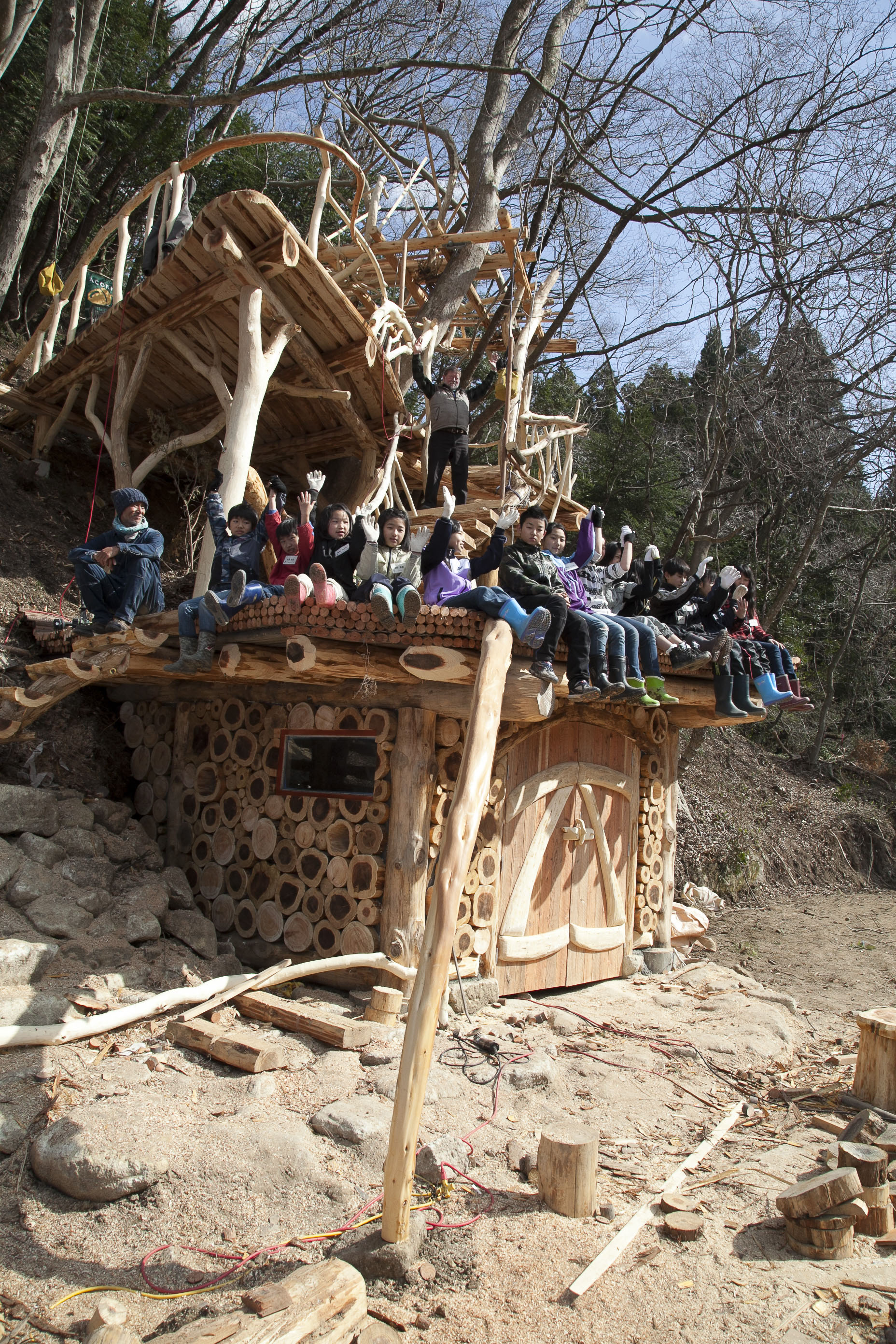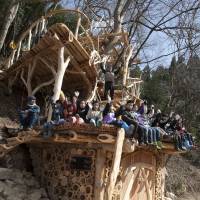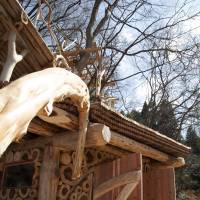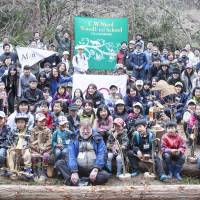Ever since the massive Great East Japan Earthquake on March 11, 2011, and the catastrophic tsunami it triggered, badly hit villages, towns and cities in the Tohoku region of northeastern Honshu have been struggling to recover and rebuild.
The going is slow and many people are losing hope. Some feel that the rest of Japan has forgotten them; many have lost any belief in a better future; and even more no longer have any trust in the government.
Despite this, others are fighting and struggling. They need support — not just funding, but human support. They need to be able to trust and believe in projects that are actually happening.
In the summer following the disaster, our Afan Woodland Trust invited people from the small city of Higashi-Matsushima on the coast of Miyagi Prefecture to come to our woods in the hills of Nagano Prefecture for three days and two nights in order to relax.
The children played in our streams, swung on "Tarzan" ropes and made all kinds of woodland discoveries. The adults walked, talked or just lazed around enjoying the good air and scenery. In the evenings, while the children had a campfire picnic dinner in the woods, the adults had a full sit-down dinner in the big hall of our new Woodland Trust Centre — a roast haunch of venison with all the trimmings.
At the end of the three days, a town official came to me, but not just to thank us for the hospitality. "We have seen the future for us; you have given us a hope and a dream. Will you please help?" he asked, looking me straight in the eyes.
Now we are officially contracted to the town to advise and help in relocating a primary school to some densely wooded hills and valleys above the tsunami danger zone where most of Higashi-Matsushima's near-43,000 folk lived and worked before that dreadful day.
I never want to go to somebody else's place and tell them what to do, but if they ask for help and advice we will do everything we can. So without delay our field experts carried out environmental surveys of the area. These revealed not only at least 11 endangered species there, but also clear evidence that millennia ago people of the Jomon culture (circa 8000 B.C. to 300 B.C.) inhabited the area. There were also old trails along which horses were once used to drag out quarried stone for building, and it was clear that the valleys, now densely wooded, had been terraced for rice paddies, with ponds dug to store water.
Over the decades nearly all of this had become densely overgrown. We advised that with some hard work cutting back brush, selectively trimming out trees and cleaning and restoring streams, the area would become rich in biodiversity and an ideal place to relocate a school.
However, I had and have my conditions, from which I will not budge. Although we understood the town could not act on all our advice, the following criteria had to be accepted if they wanted our continued support:
• Everything possible should be done to preserve the scenery, history and nature.
• The forests should not be totally cleared, nor the hilltops razed by bulldozers or the valleys all filled.
• The school should be built of wood, using traditional and modern techniques that are earthquake-proof and fire-resistant.
There was no question I would be in the least interested in helping to construct yet another ferro-concrete box.
We have had tremendous support for this, both from the community and from experts in many fields. However, Japan's construction industry has an ongoing love affair with ferro-concrete and with the attractions of many well-worn kickback and sweetener schemes.
I've written about this here before, so I won't go into it again — except to point out that things have not improved at all under the "new" Liberal Democratic Party administration of Prime Minister Shinzo Abe (which is nothing new at all but more of the same-old same-old).
Together with local children and adults, we brought volunteers to start clearing out tangled brush to let some light reach the woodland floor. Selective trimming of trees also allowed the passage of gentle breezes. Now, after just 18 months, orchids, dogtooth violets, anemones, monk's hood and many other flowers have grown. We see dragonflies and butterflies.
We have shared great meals and talks around campfires that have contributed to us and local people building a wonderful rapport. We learn a lot from each other. Grandparents are talking to grandchildren, telling them of their own childhoods and teaching them so many things that were being forgotten. Just being together in woodlands with streams stimulates this.
The dark side is that although more than two years have passed since the disaster, it looks as if it will take at least four more years before all the documents are stamped and construction of the school can begin.
Meantime, there are children still living in cramped, prefabricated emergency-relief buildings and studying in the sort of unattractive temporary buildings used on construction sites.
Many of these children are traumatized. They need natural beauty around them — and they really, urgently need homes and schools that will help foster in them a belief in the future. Of course finding jobs for the adults is a priority, too — but how can a parent put their heart and their effort into their work if their children are not safe, healthy and happy?
The children, from 3-year-olds to high school students, love our woodland programs — that's obvious from their enthusiasm and by the way they pitch in to help. But still we wanted something more: a visible base, a special happy place before we're allowed to get going on the new school buildings.
We approached Takashi Kobayashi — renowned as Japan's "tree-house guru" — to build us one of his special places for the children of Higashi-Matsushima.
Over the last 20 years, he has built about 120 tree houses from one end of the country to the other. Talking with him, I was delighted that we shared so many of the same values, and even though he was born in Japan and I on the other side of the world in Wales, we had read many of the same books. As a boy I dreamt of being friends with Tarzan and visiting his tree house, and of the tree house the Swiss Family Robinson fashioned on their deserted island. So did he. (Even now, I confess to being a little envious of my dear friend John Gathright, who brought up his sons in a tree house in Aichi Prefecture.)
Perhaps it is because we share so many of our genes with other primates that children love being able to climb trees. John's research on the effects on humans of climbing trees, research which earned him a doctorate, found that at a height of between 4 and 6 meters in a tree, children feel very safe, calm and confident. Above that height, the adrenaline kicks in. When talking to John about this, I suggested that the 4 to 6 meters height was in the safety zone from big predators on the ground, and he agreed that this might be true.
There is a wealth of evidence demonstrating that children need to spend time in nature as they grow. I don't have the space to expand on this, but if you are interested, an Internet search for "nature deficit syndrome" will yield reams of information on it — and about what can happen to children deprived of first-hand experience of nature.
Anyway, Kobayashi and his crew of volunteer carpenters and log-builders will have completed our tree house by June. Last week we had another session in the woods, and some of the children helped to plaster the walls of the ground-floor Hobbit Room.
The theme of this tree house is a dragon. It winds up a steep wooded slope, enveloping a sycamore and a mountain cherry tree as it goes. At the base, that little room — which can fit about 10 big people or 15 small ones — has a fireplace chiseled out of the bedrock and a roof that's a strong, insulated, earth- and plant-covered deck. Then a winding stair goes to another deck, rather like the forecastle of a ship, while another winding stair goes to the head of the dragon, which is a small enclosed room with round stained-glass windows. It will be a magical place when finished.
We can't hold classes for 30 or 40 children in this "Tree Dragon," but we don't need to. We will use the woods as our classroom, and the tree house as place of escape and relaxation for those children who really need it, or who need advice, guidance or just a little storytelling away from the crowds.
The children, and their grandparents and parents, can have this place as a starting point for a more confident outlook on the future. It will help them to believe that, eventually, the best school in Japan will be built in those lovely wooded hills and valleys. And us building the Tree Dragon together, entirely from local materials, helps lifts my spirits too as we continue to refute doubters and repel the forces of ferro-concrete.
And besides, the Tree Dragon tree house will also be a place where I can enjoy slipping back into childhood fantasies and maybe relish a quiet sip of the water of life in front of the little stone fireplace in the Hobbit Room.




















With your current subscription plan you can comment on stories. However, before writing your first comment, please create a display name in the Profile section of your subscriber account page.